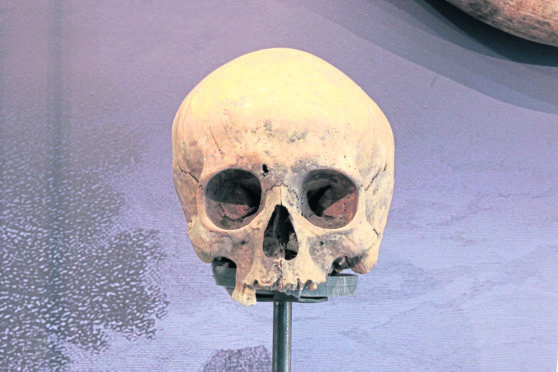It is a ghoulish souvenir, taken by one of Scotland’s most famous authors from what he called “the scene of a horrid feudal vengeance”.
Now a skull from the personal collection of Sir Walter Scott is set to play a vital role in solving the mysteries of a brutal massacre.
Legend has it that, in the sixteenth century, the entire population of the island of Eigg – nearly 400 men, women and children – were murdered when clansmen from a neighbouring island cornered them in a cave then burned them alive.
More than 200 years later, Scott – curious to investigate the bloody tale – sailed to the site of the so-called Massacre Cave and removed a skull as a keepsake.
Now, as modern science is beginning to shine a light on the circumstances of the awful murder, the trust that manages Scott’s estate have agreed to offer up the skull for analysis.
Their decision comes as new analysis of other bones, more recently discovered in the cave, suggests that one of the victims was a child only nine years old.
Camille Dressler, chair of the Eigg History Society, which has been working with Historic Environment Scotland (HES) to research the massacre, said the souvenir could yield vital clues.
She said: “The chance to examine the skull from Sir Walter Scott’s collection could be invaluable.
“It would help shed even more light on what happened in the cave. The skull has teeth which would help with analysis. I would like to see it at least loaned to the archaeologists – the more information we have the better.”
The legend of Massacre Cave is one of Scotland’s most gruesome.
Tradition states that a party of MacLeods from neighbouring Skye sailed to Eigg in 1576 and made unwanted advances towards the local girls.
The angry menfolk of Eigg – all MacDonalds – rounded up the invaders and set them adrift in an open boat.
And although the MacLeods were rescued by their fellow clansmen – they vowed to return to Eigg take their revenge.
The following year, when a legion of MacLeods stormed back to Eigg, the terrified islanders all took shelter in a secret cave by the shore. Named Uamh Fhraing – the St Francis’ Cave – it had a small low entrance covered in undergrowth, but was large enough inside to hide the entire population – said to number 395 men, women, and children.
After searching the island fruitlessly for two days the MacLeods decided to set sail – but then spotted one of the MacDonalds leaving the cave.
When the MacDonalds refused to come out of hiding, the MacLeods piled thatch and roof timbers at the cave entrance and set fire to it, damping the flames so that the cave was filled with smoke.
It was said 395 people died, either by smoke inhalation or heat and oxygen deprivation – with only one family escaping to tell the tale.
In 1814 – the same year as his seminal novel Waverley was published – Scott sailed around the Hebrides, aiming to collect material for his epic poem The Lord of the Isles.
Landing on Eigg, he found a guide who took them to the entrance to a cavern “through which one can hardly creep on hands and knees,” which then rose to a greater height, and the floor of which “is strewed with the bones of men, women and children, being the sad relics of the ancient inhabitants of the island, 200 (sic) in number who were slain.”
He wrote in his journal: “I brought off, in spite of the prejudices of our sailors, a skull, which seems to be that of a young woman.”
Scott – in his own words – was a “collector of grim cracks and rarities” which he displayed at Abbotsford, his grand mansion in the Borders, and from which he took inspiration.
Massacre Cave maintains a macabre appeal for visitors to Eigg, and in 2016, tourists found 53 human bones.
Kirsty Archer-Thompson, Abbotsford’s Collections and Interpretation Manager, said the charitable trust that manages Scott’s former home would be happy to submit the skull for scientific investigation.
She said: “The Abbotsford Trust would welcome the opportunity for further analysis and scientific study of the skull thought to have come from the Isle of Eigg, and to contributing more broadly to ongoing archaeological and historical research.
“Scott was always interested in artefacts that served to remind him of the futility of feuds, war and bloodshed and famously proclaimed that ‘life is too short for the indulgence of animosity.’”
